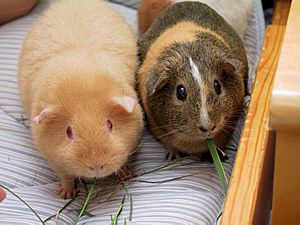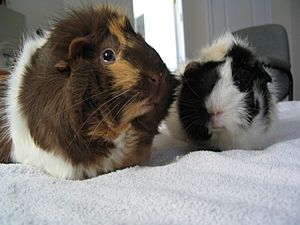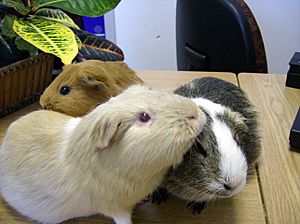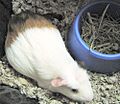Guinea pig facts for kids
Quick facts for kids Domestic guinea pig |
|
|---|---|
 |
|
| Scientific classification | |
| Kingdom: | |
| Class: | |
| Order: | |
| Suborder: |
Hystricomorpha
|
| Family: | |
| Genus: |
Cavia
|
| Binomial name | |
| Cavia porcellus |
|
Guinea pigs are small, furry animals that belong to the rodent family. Their scientific name is Cavia porcellus. Even though they are called "guinea pigs," they don't come from Guinea and are not related to pigs. Instead, these cute creatures originally came from the Andes mountains in South America. You can still find their wild relatives living there today. Long ago, people in the Andes first tamed guinea pigs to be a source of food. They are still eaten in some parts of the world.
Contents
What are guinea pigs like?
Guinea pigs are fairly large for rodents. They usually weigh between 700 and 1200 grams (about 1.5 to 2.5 pounds). They are also about 20 to 25 centimeters (8 to 10 inches) long. Most guinea pigs live for about four to five years. However, some can live as long as eight years. The longest-living guinea pig ever recorded lived for almost 15 years!
How do guinea pigs behave?
Guinea pigs are quite smart. They can learn complicated paths to find food. They can even remember these paths for many months! When they need to solve a problem, they often use movement. Guinea pigs can jump over small things, but they can't climb. They are not very quick or graceful.
These animals get scared very easily. If they sense danger, they might freeze still for a long time. Or, they might run quickly to find a safe hiding spot. If a big group of guinea pigs gets scared, they might "stampede." This means they run in all directions to confuse any animals trying to hunt them. When guinea pigs are excited, they sometimes do little hops in the air. This is called "popcorning" because they look like popcorn popping! They are also surprisingly good swimmers.
Like many rodents, guinea pigs sometimes groom each other. They also groom themselves regularly. During grooming, they use a milky-white liquid from their eyes to rub into their fur. Male guinea pigs might chew on each other's fur. This is usually a way to show who is in charge in the group, not a friendly gesture. They also show who is dominant by biting (especially ears), raising their fur, making aggressive noises, head-butting, and even leaping attacks.
Guinea pigs as pets
Many people around the world keep guinea pigs as pets. In countries like Peru and Bolivia, they are still raised for food. The very first people who tamed these animals did so for food. Besides being pets and food, some people believe guinea pigs can keep away bad spirits. In Quechua, the language of some native tribes in Peru, guinea pigs are called quivi. Spanish speakers in the region call them cuy (pronounced "koo-ee").
Guinea pigs don't see very well. But they have excellent senses of hearing, smell, and touch. They mostly talk to each other using different sounds.
What do guinea pigs eat?
Grass is the natural food for guinea pigs. Their molars (back teeth) are perfect for grinding plants. These teeth also grow continuously throughout the guinea pig's life.
It's good for guinea pigs to eat fresh grass hay every day. They also benefit from special guinea pig food pellets. Alfalfa is another popular food. Most guinea pigs love to eat a lot of alfalfa. Some pet owners and vets suggest that eating too much alfalfa might make guinea pigs overweight. It could also lead to bladder stones because it has a lot of calcium. This is especially true for adult guinea pigs that are not pregnant. However, some scientists say alfalfa is a good source of protein, amino acids, and fiber.
Housing and breeding guinea pigs
Guinea pigs need large cages with plenty of open space to run and play. They should eat about 1/8 cup of high-quality, grass-based guinea pig pellets daily, following the instructions on the package. They also need unlimited grass hay and at least one cup of various fresh vegetables every day. Guinea pigs generally enjoy being held.
It's best to keep guinea pigs in cages larger than 7.5 square feet. If you have two guinea pigs, they need at least 10.5 square feet. Guinea pigs are social animals, so they should always have a friend.
It is not recommended to breed guinea pigs. This is because there is a high chance of problems during pregnancy.
Other uses of the term
The term "guinea pig" is also used as slang. It can mean a person who is the first to try something new. It can also mean someone who is the subject of an experiment. This is because scientists have often used guinea pigs in biology experiments.
Images for kids
-
A pregnant female guinea pig one week before giving birth to three babies
-
Guinea pigs are characters in the famous book Alice's Adventures in Wonderland (1907)
-
A traditional Peruvian dish made with cuy
-
Guinea pigs being raised as livestock in Peru
-
A guinea pig being checked by a vet for a study on leptospirosis
See also
 In Spanish: Cuy para niños
In Spanish: Cuy para niños












